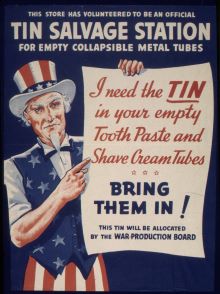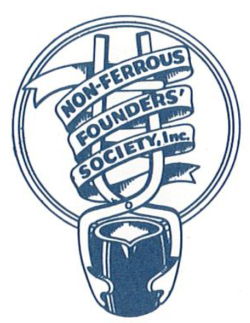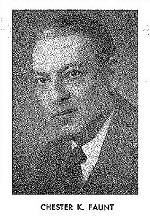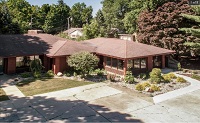History of NFFS
Established in 1943
 In January 1942, President Franklin D. Roosevelt established the War Production Board (WPB) with Executive Order 9024. The national WPB’s primary task was converting civilian industry to war production. The WPB assigned priorities and allocated scarce materials such as steel, aluminum, copper and rubber, prohibited nonessential industrial production such as nylons and refrigerators, controlled wages and prices, and mobilized the people through patriotic propaganda such as “give your scrap metal and help Oklahoma boys save our way of life.” It initiated events such as scrap metal drives, which were carried out locally to great success. For example, a national scrap metal drive in October 1942 resulted in an average of almost eighty-two pounds of scrap per American.
In January 1942, President Franklin D. Roosevelt established the War Production Board (WPB) with Executive Order 9024. The national WPB’s primary task was converting civilian industry to war production. The WPB assigned priorities and allocated scarce materials such as steel, aluminum, copper and rubber, prohibited nonessential industrial production such as nylons and refrigerators, controlled wages and prices, and mobilized the people through patriotic propaganda such as “give your scrap metal and help Oklahoma boys save our way of life.” It initiated events such as scrap metal drives, which were carried out locally to great success. For example, a national scrap metal drive in October 1942 resulted in an average of almost eighty-two pounds of scrap per American.
 WPB order M-9-C related to the conservation of copper and it severely limited the availability of non-ferrous foundries to obtain the metals they needed such as copper and aluminum. As a result of M-9-C, non-ferrous foundries were having significant problems in obtaining critical supplies of metals to both manufacture war goods and to satisfy domestic casting needs of customer industries.
WPB order M-9-C related to the conservation of copper and it severely limited the availability of non-ferrous foundries to obtain the metals they needed such as copper and aluminum. As a result of M-9-C, non-ferrous foundries were having significant problems in obtaining critical supplies of metals to both manufacture war goods and to satisfy domestic casting needs of customer industries.
 Another challenge facing foundries in 1943 was the Office of Price Administration (OPA), established by Executive Order of the President on April 11, 1941. The OPA had the power to place ceilings on all prices except agricultural commodities, and to ration scare supplies of other items, including metals. In 1943, the OPA instituted a $0.015 uniform price reduction on all castings to “continue a situation in which prices were definitely known and knowable to purchasers.” Foundries were being dictated a price reduction in an environment where the raw materials, such as scrap and ingot, did not decrease in cost. This presented an untenable situation for foundries, and many foundries were placed at great risk of economic harm and/or failure.
Another challenge facing foundries in 1943 was the Office of Price Administration (OPA), established by Executive Order of the President on April 11, 1941. The OPA had the power to place ceilings on all prices except agricultural commodities, and to ration scare supplies of other items, including metals. In 1943, the OPA instituted a $0.015 uniform price reduction on all castings to “continue a situation in which prices were definitely known and knowable to purchasers.” Foundries were being dictated a price reduction in an environment where the raw materials, such as scrap and ingot, did not decrease in cost. This presented an untenable situation for foundries, and many foundries were placed at great risk of economic harm and/or failure.
 In turn, non-ferrous foundries organized into what became NFFS to represent their collective interests. NFFS first organized on April 28, 1943 at the Statler Hotel located in in St. Louis, Missouri during the A.F.A. Congress. Its main purpose at the time was to work directly with the War Production Board to help non-ferrous foundries obtain critical supplies of scrap and ingot metal for casting production needs, and to represent the industry to the OPA to try and protect the industry from damaging economic policies.
In turn, non-ferrous foundries organized into what became NFFS to represent their collective interests. NFFS first organized on April 28, 1943 at the Statler Hotel located in in St. Louis, Missouri during the A.F.A. Congress. Its main purpose at the time was to work directly with the War Production Board to help non-ferrous foundries obtain critical supplies of scrap and ingot metal for casting production needs, and to represent the industry to the OPA to try and protect the industry from damaging economic policies.
 Seventy-six executives of 66 non-ferrous companies attended the inaugural session where a board of 18 directors was elected by the membership. The board, in a meeting held immediately after adjournment, then selected from among its own number an executive committee, which committee in turn selected the 1943-44 slate of officers. The officers elected were: President, Chester K. Fount, Christensen & Olsen Foundry Co., Chicago; Vice President, Edwin W. Horlebein, Gibson & Kirk Co., Baltimore; secretary-treasurer, R. M. McClure, Chicago and Washington.
Seventy-six executives of 66 non-ferrous companies attended the inaugural session where a board of 18 directors was elected by the membership. The board, in a meeting held immediately after adjournment, then selected from among its own number an executive committee, which committee in turn selected the 1943-44 slate of officers. The officers elected were: President, Chester K. Fount, Christensen & Olsen Foundry Co., Chicago; Vice President, Edwin W. Horlebein, Gibson & Kirk Co., Baltimore; secretary-treasurer, R. M. McClure, Chicago and Washington.
 The NFFS offices were originally located in downtown Chicago, Illinois. The offices were relocated to Cleveland, Ohio, during the 1960s, and returned back to Illinois in the 1970s with offices located in the old Cast Metals Federation building located next to the American Foundry Society (AFS) in Des Plaines, Illinois. The offices again moved in 1998 to Park Ridge, Illinois, and then in 2019 to their current location in Sturgis, Michigan (pictured right).
The NFFS offices were originally located in downtown Chicago, Illinois. The offices were relocated to Cleveland, Ohio, during the 1960s, and returned back to Illinois in the 1970s with offices located in the old Cast Metals Federation building located next to the American Foundry Society (AFS) in Des Plaines, Illinois. The offices again moved in 1998 to Park Ridge, Illinois, and then in 2019 to their current location in Sturgis, Michigan (pictured right).
From its inception, NFFS was created to assist non-ferrous foundries in dealing with government regulations and to represent the industry when government rules and regulations affected its member’s businesses. While the names and faces of the members, directors and staff for the Society may have changed over the past 75 years, the focus of the Society has remained to represent the concerns and interests of the non-ferrous metal casting industry. We hope that 75 years from now (Year 2093!) that future NFFS members will look back at our efforts and conclude that we effectively worked together to continue the tradition of excellence and representation established way back in 1943.
Today, our vision is “advancing the manufacturing, recycling, and use of non-ferrous castings.” To this end, the Society has developed a full range of programs and services designed to help foundry leaders successfully operate their businesses.
